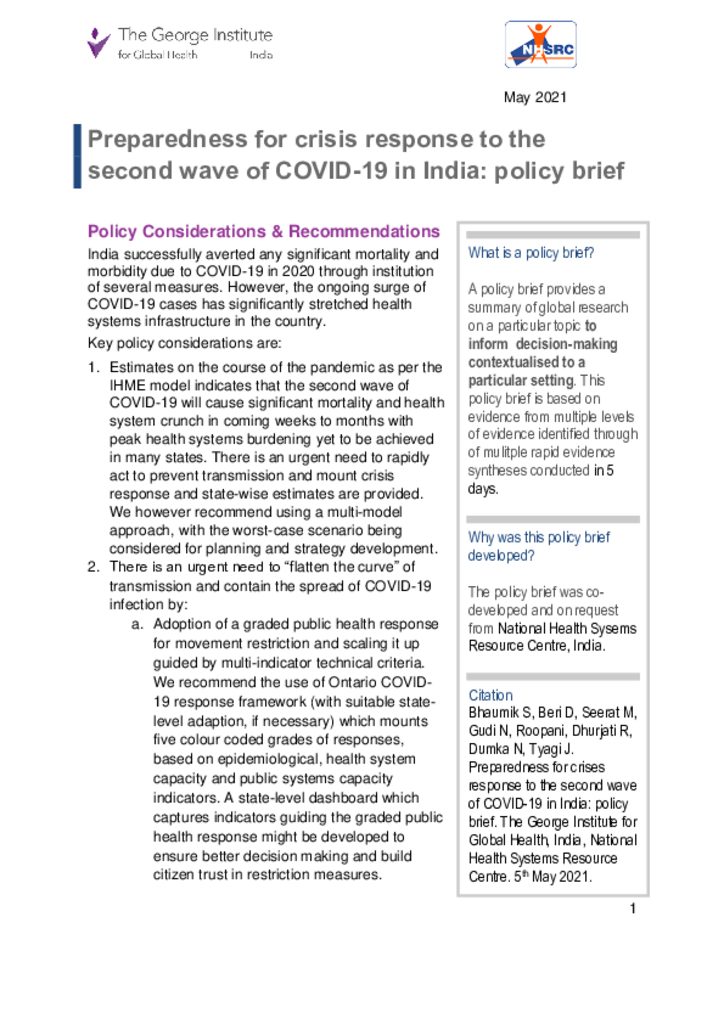
Preparedness for crisis response to the second wave of COVID-19 in India: policy brief
India successfully averted any significant mortality and morbidity due to COVID-19 in 2020 through institution of several measures. India is now facing the second wave of COVID-19 which has overwhelmed the health system. State governments have revised strategies to deal with the pandemic surge but there is a need for crisis preparedness response on the second wave of COVID-19 in India. The National Health Systems Resource Centre (NHSRC) requested the George Institute for Global Heath for rapid evidence synthesis for the purpose. scanned key issues and developed an evidence informed policy brief which had the following objectives:
- To understand the magnitude of the second wave of COVID-19 at a national and state level, together with resource requirements,
- To synthesise evidence on interventions that can flatten the curve” of transmission and contain the spread of COVID-19 infection,
- To identify strategies and synthesis evidence for rapidly scaling up health systems capacity during COVID-19 surges.
The policy brief is based on synthesis of six public health graded response frameworks, 115 research studies on several aspects, two reviews, and presents one inventory of resources. We also present estimates from one model to inform magnitude and temporality of the pandemic which can inform planning. All rapid evidence synthesis and policy brief development was carried out in 5 days.
Key policy considerations and recommendations are:
- Estimates on the course of the pandemic as per the IHME model indicates that the second wave of COVID-19 will cause significant mortality and health system crunch in coming weeks to months with peak health systems burdening yet to be achieved in many states. There is an urgent need to rapidly act to prevent transmission and mount crisis response and state-wise estimates are provided. We however recommend using a multi-model approach, with the worst-case scenario being considered for planning and strategy development.
- There is an urgent need to “flatten the curve” of transmission and contain the spread of COVID-19 infection by:
- Adoption of a graded public health response for movement restriction and scaling it up guided by multi-indicator technical criteria. We recommend the use of Ontario COVID-19 response framework (with suitable state-level adaption, if necessary) which mounts five colour coded grades of responses, based on epidemiological, health system capacity and public systems capacity indicators. A state-level dashboard which captures indicators guiding the graded public health response might be developed to ensure better decision making and build citizen trust in restriction measures. Evidence on different types of restriction measures is presented and other graded public health response frameworks is also presented.
- A multi-component community-based intervention to remove barriers to access and promote mask usage consisting of the following components needs to be invested on and scaled up across India:
- Engaging community-based organisations to ensure availability of free surgical masks (free door-to-door distribution of surgical mask would be appropriate strategy after surge is over),
- Offering information on mask usage and disposal with videos on tab, brochure in local languages and other community-based platforms,
- Endorsement and advocacy by local community leaders – healthcare, social, political and cultural,
- Periodic in-person monitoring of mask usage including providing reminders and distribution in public spaces,
- Development of protocols for disposal of masks in safe and environment friendly manner.
- Ensuring health system preparedness for COVID-19 surge:
- Urgent investments to ensure scaling up of a crisis health system (for both COVID and non-COVID needs) is required. Evidence on several strategies (shelter hospital /alternate hospital sites; mobile field hospital, Biocontainment patient care units; recovery /rehabilitation units; deployment of hospital ships and planes; escalating ICU/HDU resources in ICU; community care facilities; hospital re-engineering; medical missions) used successfully in other countries for COVID-19 surge is presented. We recommend institution of all modalities, as relevant, considering the magnitude of crisis.
- Shortfalls in ventilator requirements, after purchase through routine supply chains and those received through aid, might be met by requesting support from organisations with capacity to manufacture open source ventilators. A resource on ranking of open source ventilator on several parameters is presented. Training for critical-care staff and accessories for ventilators including oxygen delivery need to be addressed.
- There is an urgent need to support people with COVID-19 who can undergo home care safely and scale up telemedicine provided by registered medical practitioners. Telemedicine facilities should be linked to transportation and hospital admission facilities such that severe patients can be optimally managed.
- The government needs to urgently develop and implement a fair, just and transparent triaging criterion for rationale allocation of beds, oxygen, and other critical care resources in consultation with bioethicists. Evidence on different triaging strategies is presented in the form of an inventory.
Related people:
- Soumyadeep Bhaumik, Research Fellow, The George Institute for Global Health
- Deepti Beri, Research Officer, The George Institute for Global Health
- Jyoti Tyagi, Research Officer, The George Institute for Global Health
- Rupasvi Dhurjati, Research Assistant, The George Institute for Global Health
- Nachiket Gudi, Consultant, The George Institute for Global Health


